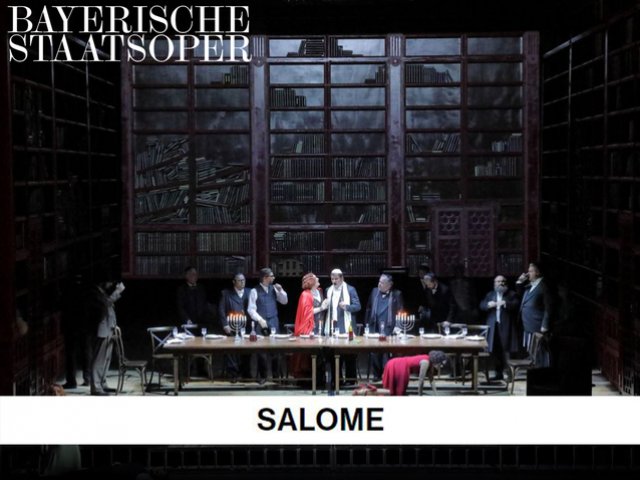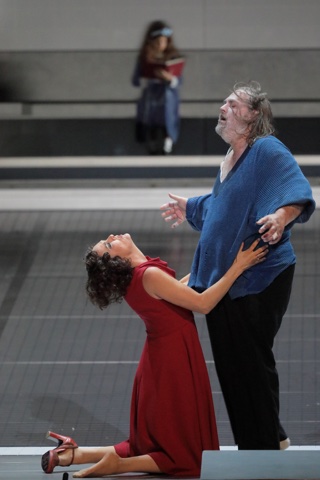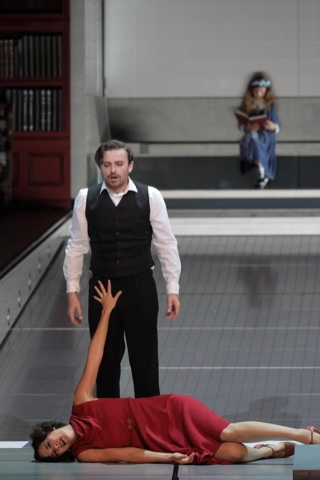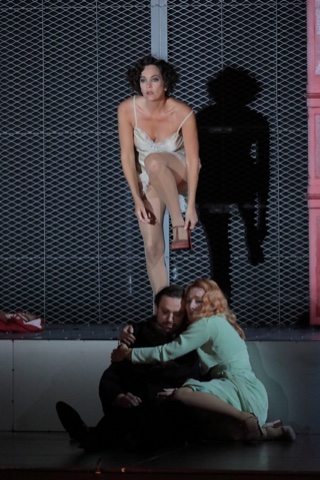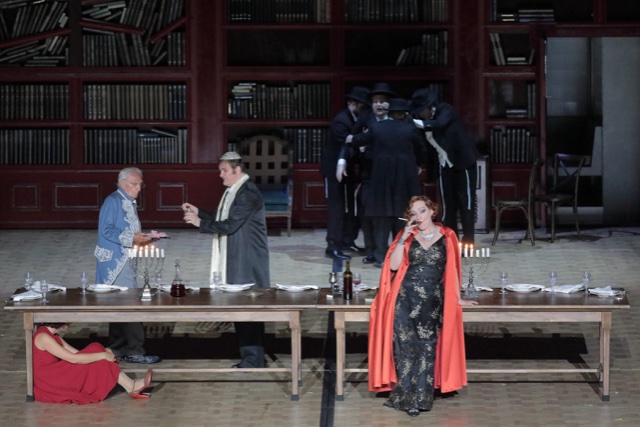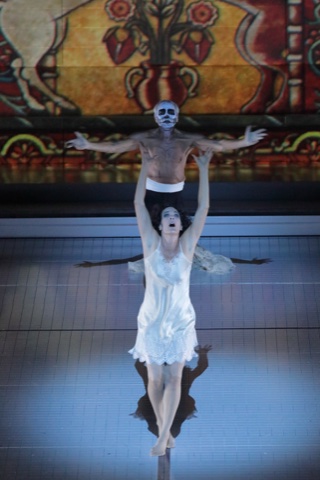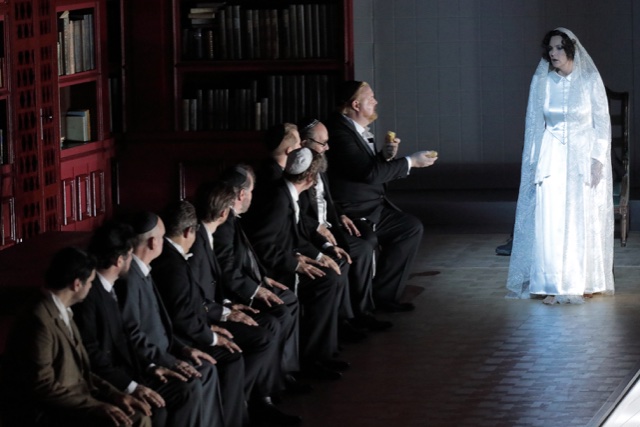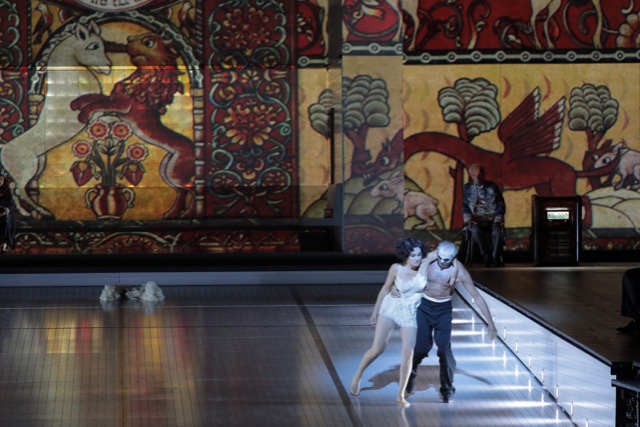Salome in Munich
Marlis Petersen, Kirill Petrenko and Krzysztof Warlikowski
By: Susan Hall - Jul 26, 2021
The Munich State Opera is presenting Salome, the opera by Richard Strauss. The set is dark, yet in full view as we enter the opera house. A man is fidgeting over a desk deep in the set. On it sits a banker’s lamp with its classic green hood. A patent for this lamp was taken out in 1909. In a prologue to the opera, Mahler songs are being sung, another brief clue to date the monumental, elegant setting created by Malgorzata Szczesniak.
Strauss had followed Oscar Wilde’s notorious play Salome closely in creating the opera. At its Dresden premiere, the opera received 38 curtain calls. It has always been popular.
Both the play and the opera are set out of time and place.This Munich production is too. Hints of impending doom for Jews in Germany are there, with a whiff of the early 20th century. Yet overall we meet archetypes: A lecherous Herodes, far from his magnificent building projects; Salome, driven by desire, yet perhaps for salvation as well as sexual satisfaction. Herodias, an enraged and jealous wife.
The gargantuan height of the large library, filled with bookcases which cover three sides of the stage walls, sets up a big story. At the lip of the stage, separate action takes place on a walk.
The library is very dark throughout the opera, suggesting it is a place of safety against a threatening outside world, but also containing desires and hates that are impermissible beyond its walls. Latticed doors occasionally admit characters. Through their cut-outs, light dances mysteriously in the space.
The brightest light on stage comes when the set parts to reveal the bright space in which Jockanaan is confined. It is also the floorboard for much of Salome's dance. A further opening high at the back of the stage, behind the back bookcase, admits the light of the moon, often referenced as the opera begins.
Herodias’ page, a woman, is talking about the moon with the young Syrian guard, Narraboth. She repeatedly notes that the young Syrian is looking at Salome too much. Her mistress, Herodias, will also take up this cry. Krzysztof Warlikowski makes striking use of doubles in his work. This business of looking precipitates crises. In the end, the squabbling, intellectually-challenged Jews will watch the story of Salome as they await their own fate.
Warlikowski’s gift is to make past works present by this insertion of double vision, or doubled couples acting the same emotion. The page and the young Syrian mirror Salome and Jockanaan. The play Salome appears as a story within the opera, entertainment for the Jews, as they wrestle with the possibility of their extinction.
While the literal time setting is subtle, Jews have been threatened throughout history. Herod himself, as successful as he was as a Jewish leader, had to kowtow to Rome. He may have kept the Emperor at bay. Yet this was only because he took Rome’s side whenever it became necessary.
The play within the play, the doubling and the repetition of phrases are like the ritualistic effects provided by the composer. Warlikowski takes them and translates the story into a universal and timeless theme.
Early on in the opera, Salome, daughter of Herodias and step-daughter of Herodes, has stepped out to get away from the salon gathering. She hears the voice of Jockanaan, imprisoned below the library, as he sings of the coming of a new Messiah, She is transfixed and then erotically charged.
Marlis Petersen first took on this role in Munich with conductor Kirill Petrenko in 2019 in the production being reprised for the Munich Opera Festival.
In 2016 at St. John the Divine in New York, a cathedral named after Jesus’ apostle, not the John we meet here, Petersen, did her Brahms’ Requiem solo from a swing, pushing herself to and fro. She had already been on the set for forty minutes. Lying still. Dead and then spirited away. We noted then: “Petersen’s coloratura voice is flawless as it lofts its way through to victory as the sting of death is removed. She goes ever higher and higher on her swing, touching the heavens with heavenly sounds. They course through the audience with sheer pleasure.”
Now as Salome she is attracted to the music of Jockanaan. The message is embedded in his tones: a Messiah, far greater than he, is now in Galilee, turning water to wine and curing lepers.
Salome is eroticized by the music and the message. She cannot get enough of this prophet. Everyone around her tries to pull her away, but this only strengthens her resistance.
Watchfulness is the mode of the moment. Herod has eyes only for his stepdaughter. His wife tells him to stop looking. Salome has eyes only for Jockanaan, and everyone tells her to stop looking. Her mother is furious at the prophet who repeatedly says Herodias is evil and an adulterous. Of course, she is
Jews and Nazarenes gather for a banquet in the library. Salome is tucked under the table, a present/absent guest. She will not bend her will to Herod’s.
There are twelve at the table, which looks like The Last Supper which John the Divine attended. The ten Jews and Nazarenes make a minyan, the quorum required for a gathering of Jews to have religious import.
Petersen is thoroughly infused in her character. During the rehearsal period, both the conductor Kirill Petrenko and the director Warlikowski work together developing the staging. (Crowded schedules leave conductors in the US to phone in their performances). Petrenko’s performances have integrated music, drama, setting: every element unfolding in the opera house.
Petrenko captures all the richness of the score, yet he also suggests subtle gestures which Strauss created to reflect Wilde's melodious phrases, chiming repetition and fugal effects. All art may aspire to music. Wilde wrote his play originally in French, the language he often referred to as music. Petrenko brings out the four horns which herald Jockanaan and rapid runs of notes leap up to a trill, making a frenzied, helter-skelter gesture.
With a performance like Marlis Petersen’s, you probably could have a bare set. It is to Warlikowski's credit that he adds something, a difficult achievement when Petersen is at the top of her form. Petrenko encompasses the brilliant send-up from the pit.
How modern Salome is in Munich.
Conductor Kirill Petrenko
Production Krzysztof Warlikowski
Set Design Malgorzata Szczesniak
Lighting Felice Ross
Video Kamil Polak
Choreography Claude Bardouil
Herodes Wolfgang Ablinger-Sperrhacke
Herodias Michaela Schuster
Salome Marlis Petersen
Jochanaan Wolfgang Koch
Narraboth Pavol Breslik
Ein Page der Herodias Rachael Wilson
Erster Jude Scott MacAllister
Zweiter Jude Roman Payer
Dritter Jude Dean Power
Vierter Jude Kevin Conners
Fünfter Jude Callum Thorpe
Erster Nazarener Derek Welton
Zweiter Nazarener Ulrich Reß
Erster Soldat Martin Snell
Zweiter Soldat Bálint Szabó
Ein Cappadocier Theodore Platt
Eine Sklavin Eliza Boom
Frau des Cappadociers Sophia Julia Schützinger
Der Tod Peter Jolesch
Free performances on demand from Munich here.

